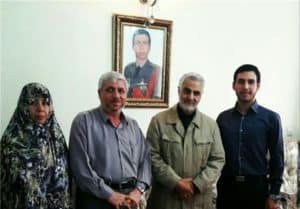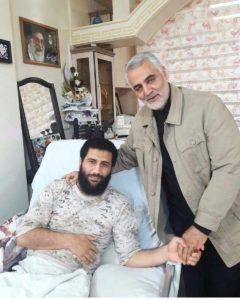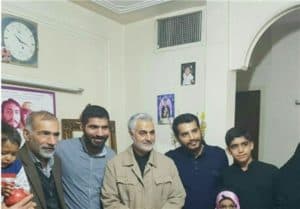
Photo 1. Qassem Soleimani visiting the family of the first regular Army fatality in Syria. Credit: Fars News Agency.
Major General Qassem Soleimani, the commander of the Islamic Revolutionary Guard Corps Qods Force (IRGC-QF), was spotted in Tehran today visiting the families of Iranians killed during fighting in Syria. Previously, on Oct. 23, Soleimani was in Iraqi Kurdistan and was photographed visiting the family of a Peshmerga commander who was killed last year. Some Iranian media outlets claim that Soleimani was near Mosul on Oct. 17, when the siege of Mosul was launched, but that cannot be confirmed at this time.
Soleimani visited the households of Iranians who lost members to the war in Syria, and met with an IRGC member paralyzed from combat wounds (photo 2).

Photo 2. Soleimani visited IRGC member wounded in Syria. Credit: pro-IRGC social media accounts.
The senior Iranian commander met with the family of the first Army fatality in Syria who was killed in April (photo 1): a Second Lieutenant in the Army 65th Airborne Special Forces Brigade who has been posthumously promoted to Captain.

Photo 3. Soleimani meeting with family of Iranian commander in Afghan Fatemiyoun Division. Credit: Farda News.
Soleimani furthermore visited the family of Mostafa Sadrzadeh (AKA “Abu Ebrahim), who was killed near Aleppo, Syria, last year (Photo 3). Sadrzadeh was an Iranian commander in the all-Afghan Fatemiyoun Division, which is unusual as the unit is prohibited from accepting Iranians. Sadrzadeh disguised himself as an Afghan national in order to fight in Syria, according to Iranian media. The IRGC-QF established the Fatemiyoun as a brigade in 2013, though Afghan fighters were in Syria as early as 2011. The Fatemiyoun was upgraded last year to a division, but the actual figure is believed to be less than the 10,000 that normally constitutes a division.
Qassem Soleimani has also met with the family of an IRGC member killed in Khan Touman in southern Aleppo countryside in January. His body was returned to Iran in June.
Combatants mobilized by the Islamic Republic to fight in Syria are called “defenders of the shrine.” Waging holy war to defend the shrine of Sayyida Zaynab in Damascus and Shiite shrines in Iraq following the incursion of the Islamic State have served as rallying cries for Shiite jihadists.
Although defending the shrines in Syria and Iraq are very important, the pillars of Tehran’s strategies in the heartland of the Middle East as executed by Soleimani are comprised of more secular objectives.
In Syria, Tehran has intervened to maintain a supply route to Lebanese Hezbollah, prevent the fall of the Baathist government of Bashar al Assad, and should Assad fall, create the conditions for an Alawite-led statelet allied with Iran.
In Iraq, the Iranian government seeks to prevent the country from devolving into a completely failed state, strengthen influence over the state’s levers of power, consolidate the formation of an Iraqi version of the IRGC, and facilitate the strengthening of entities that are amenable to Tehran’s interests, such as IRGC-backed Shiite militias and the Patriotic Union of Kurdistan (PUK), in order to ensure that Iran asserts a dominant position in Iraq post-Islamic State.
The Islamic Republic’s activities are components of a broader strategy to transform into the dominant power in the Middle East.
Are you a dedicated reader of FDD's Long War Journal? Has our research benefitted you or your team over the years? Support our independent reporting and analysis today by considering a one-time or monthly donation. Thanks for reading! You can make a tax-deductible donation here.








1 Comment
All niceties aside, the good general has made his and Iran’s intentions clear. Through the utilization of these foreign fighters set up in the likeness of the irgc, to eventually have them on the borders of Israel, Jordan and Saudi Arabia. Does he believe the world body will recognize a government in Syria that represents only a small fraction of the population? Apparently he and his cronies do. This has a long way to go, way beyond ISIS , who in the end (?) Will be remembered as but a footnote in what’s to follow.